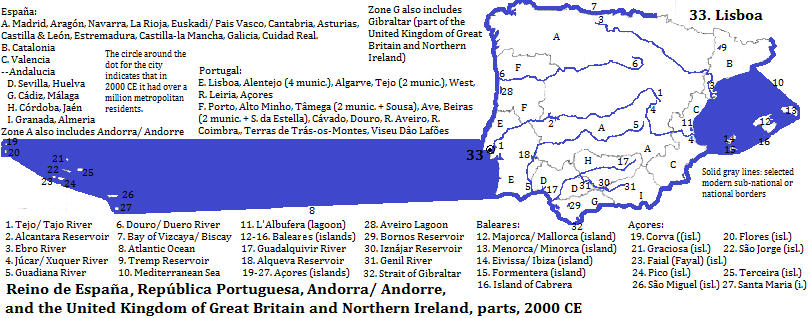Lisboa
Lisboa (Lisbon in English), Portugal's capital, is at the mouth of the Tejo1 where it widens to become the Mar da Palha (Sea of Straw). Depsite its antiquity, the buildings are mostly from after 1755 when a catastrophic earthquake destroyed 9,000 buildings. It has more than 2.8 million metropolitan residents2 and half a million city ones.3 The city became more populous than other cities on the Iberian Peninsula by 1700 CE.4
There are two bridges over the Tejo: the April 25 Bridge (1966) and the Vasca da Gama Bridge (1998). Among other famous structures are the Santa Engrácia church (started in the 17th century, finished in the 20th); the Aqueduct of the Águas Livres (started in the 18th century, finished in the 19th); the Elevador de Santa Justa (1902), an observation tower; the 16th century Torre de (tower of) Belém; the Statue of Dom Pedro IV; the ruins of the Convent of Carmo; the Castle of São Jorge, with parts dating back to 600 BCE; the Sé Catedral (cathedral) of Lisboa, completed in the 14th century at the site of vestiges from the Roman, Visigothic and Moorish eras; the Igreja of São Vicente de Fora, a church that was completed in 1629; and the Mosterio dos Jerónimos (Monastery of the Heironymites). While the April 25 Bridge is the tallest structure, the tallest modern building is the Torre São Rafael, a 24 story, 361 foot residential skyscraper that was completed in 2004.5 The Torre de Belém and the Mosterio Jerónimos together constitute a World Heritage Site. The former is famed for its architectural sculptures. The monastery features crosses of the Knights of Christ on the parapets and ribbed cupolas reminiscent of Moorish art, as well as architectural sculptures.6
Within the metropolitan area is the city of Sintra, which in 2011 had a population of nearly 378 thousand.7 UNESCO honors its landscape with World Heritage status, honoring the 19th century Romantic buildings and gardens, especially the Pena Palace, but also some buildings and ruins that date from before the 1755 earthquake.6
Lisboa's airport is the nation's only one with over ten millions passengers a year.8 The city is an important tourist destination.9
| Year | Population | Political entity |
| 1700 CE | 188,0004 | Reino de Portugal (Portuguese Empire) |
| 1800 CE | 237,0004 | Reino de Portugal (Portuguese Empire) |
| 1900 CE | 363,0004 | Reino de Portugal (Kingdom of Portugal) |
| 2014 CE | 2,800,0002 | República Portuguesa (Republic of Portugal) |
External references
Interior of the Mosterio dos Jerónimos (Monastery of the Heironymites), Lisboa (Lisbon), Portugal
Historical maps



Footnotes
1. Tajo in Spanish and Tagus in English.
2. Eurostat Larger urban zone (2014) column of https://en.wikipedia.org/wiki/List_of_metropolitan_areas_in_Europe, accessed December 28, 2015.
3. 2011 figure from the side banner of https://en.wikipedia.org/wiki/Lisbon, accessed April 5, 2016.
4. Estimates in Tables of the World's Largest Cities, in Tertius Chandler, Four Thousand Years of Urban Growth, 2nd ed. (The Edwin Mellen Press, 1987). It was the largest city in the Iberian peninsula in 1700 and 1800 CE.
5. Information about buildings and other structures comes from emporis.com, accessed April 5, 2016.
6. According to UNESCO, World Heritage Sites (Firefly Books, 2010).
7. Side bar of https://en.wikipedia.org/wiki/Sintra, accessed December 28-30, 2015.
8. List_of_busiest_airports_in_Portugal, 2013 table, accessed December 30, 2015.
9. www.touropia.com/tourist_attractions_in_Portugal/, accessed December 30, 2015.



